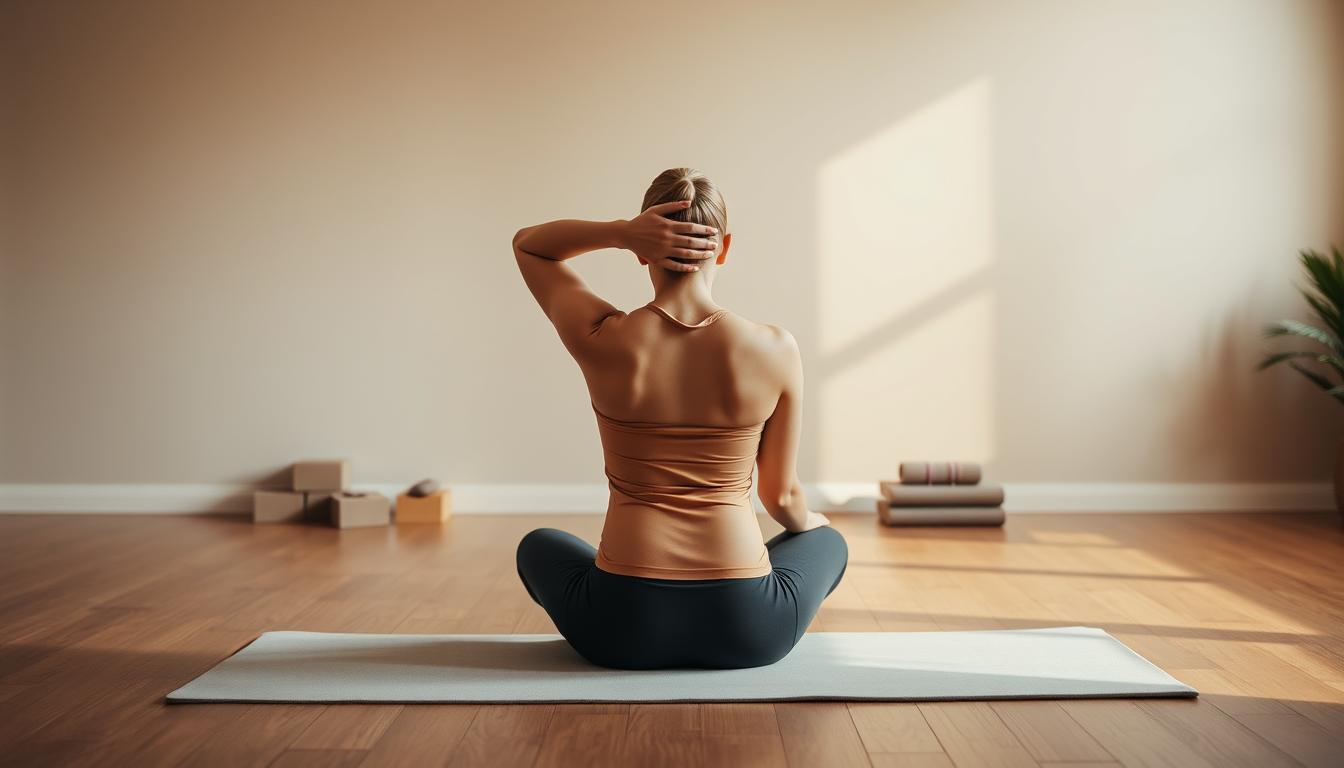You can ease neck and shoulder tension with simple exercises at home. Neck and shoulder tightness is common, often caused by slouching, stress, or repetitive strain.

Fortunately, there are gentle stretches to help. These stretches are easy to follow and can be done at home. They provide relief from neck and shoulder tension.
Key Takeaways
- Simple stretches can help relieve neck and shoulder tension.
- Gentle exercises can be done at home to alleviate discomfort.
- Poor posture and stress can contribute to tension.
- Regular stretching can help prevent future tension.
- Relief from neck and shoulder tension is achievable through gentle stretches.
Why Neck and Shoulder Tension Happens
Neck and shoulder tension can come from many things in your life. It’s often a mix of factors that affect your muscles and health.
Poor Posture and Screen Time
Poor posture, like when using digital devices, is a big cause. Prolonged screen time puts strain on your neck and shoulders. Doing posture correction exercises can help ease this tension.
https://www.youtube.com/watch?v=YBfikh0i21w
Stress and Emotional Factors
Stress and emotions also cause neck and shoulder tension. When stressed, your muscles tighten, causing pain. Doing daily stretches for neck and shoulders can help relax you.
Sleep Positions and Movement Patterns
Your sleep and daily movements can also lead to tension. Sleeping in odd positions or repeating the same motions can lead to muscle tension and stiffness. Being aware of your sleep and using tension headache prevention techniques can help.
1. The Health Impact of Chronic Tension
Chronic neck and shoulder tension can harm your health in many ways. If not treated, it can cause problems that affect your body and life quality.
Connection to Headaches and Migraines
Chronic neck tension often leads to headaches and migraines. Tight muscles in the neck and shoulders can send pain to the head. This can cause a lot of discomfort and even migraine attacks. Doing neck mobility exercises can help ease this tension and lower headache frequency.
Effects on Mobility and Range of Motion
Chronic tension also affects your ability to move. Tight muscles in the neck and shoulders make it hard to move your head and arms. This stiffness can make everyday tasks, like driving or working on a computer, more difficult. Adding best stretches for upper back pain to your routine can help keep you flexible and reduce stiffness.
Relationship to Fatigue and Energy Levels
Also, chronic tension can make you feel tired and low on energy. Your body uses more energy to stay upright and move when it’s tense. By learning to relieve neck pain naturally through stretching and relaxation, you can boost your energy and well-being.
In summary, chronic neck and shoulder tension has many health impacts. It affects not just your physical comfort but also your life quality. It’s important to address this tension with the right stretches and exercises to avoid its negative effects.
2. Benefits of Regular Stretching for Neck and Shoulder Tension Relief
Stretching regularly can ease neck and shoulder pain. Adding stretches to your daily routine boosts your well-being.
Increased Blood Flow and Circulation
Stretching boosts blood flow to your neck and shoulders. This helps nourish and heal these areas. You might feel less pain and more energy.
Improved Posture and Alignment
Improving flexibility through stretching can support better posture and muscle alignment. This reduces muscle imbalances. Proper alignment lessens neck and shoulder strain, preventing future pain.
Reduced Muscle Stiffness and Pain
Stretching regularly cuts down muscle stiffness and pain. It makes moving easier, great for desk workers or those with repetitive tasks.
Enhanced Relaxation and Stress Relief
Stretching not only relaxes the body but also soothes the mind, helping to ease daily stress. This can improve your mood and sleep.
Make stretching a part of your daily life. You’ll see a big drop in neck and shoulder tension.
3. Essential Safety Tips Before You Start
Before starting neck and shoulder stretches, it’s key to know how to stay safe. This way, you can ease tension without hurting yourself.
Warming Up with Light Movements
Start with gentle movements to get your muscles ready. Gentle neck rotations or mild aerobic activity can relieve tension and boost circulation. This step is important for preventing injuries and making your stretches work better.
Proper Breathing Techniques During Stretches
Right breathing is key when stretching. Deep, controlled breaths relax your muscles, making stretches more effective. Breathe in before stretching, and out as you stretch deeper.
Recognizing the Difference Between Stretch and Pain
Always listen to your body—stretching should feel like a mild pull, never a sharp or painful sensation. If you feel pain, stop right away to avoid injury.
When to Modify or Skip a Stretch
Know your body’s limits. If a stretch hurts or feels uncomfortable, change it or skip it. Listening to your body and adjusting your routine is key for tension headache prevention and safety.
By following these safety tips, you can stretch safely and effectively. This helps with posture correction exercises and eases neck and shoulder tension.
4. 5 Gentle Neck and Shoulder Tension Relief Stretches
These five stretches are simple yet effective. They can help you find relief from neck and shoulder tension. Adding these gentle stretches to your daily routine can reduce muscle stiffness and improve your well-being.
1. Neck Tilt Stretch
The Neck Tilt Stretch targets the muscles on the sides of your neck. It’s a simple exercise that relieves tension and improves flexibility.
Step-by-Step Instructions
Begin the Neck Tilt Stretch by gently leaning your head toward your right shoulder. Bring your ear towards your right shoulder. Pause in the stretch for a few seconds, then slowly bring your head back to center. Repeat on the left side.
Keep your shoulders relaxed and down during the stretch. Avoid forcing your ear towards your shoulder if you feel resistance.
Proper Form and Technique
It’s important to maintain proper form for the stretch’s effectiveness and to prevent injury. Keep your chin level and avoid tilting your head forward or backward.
Duration and Repetitions
Hold the stretch for 15-30 seconds. Repeat 2-3 times on each side. You can do this stretch several times a day, if you sit for long periods.
2. Shoulder Roll Stretch
The Shoulder Roll Stretch relieves tension in your shoulders and improves your posture. It’s easy to do and can be performed anywhere.
Step-by-Step Instructions
Begin with forward shoulder circles, repeating a few times before reversing the direction to backward rolls.
Make smooth, controlled movements. Avoid jerky or bouncy movements, as they can cause more tension.
Creating Smooth, Controlled Movements
For the best results, practice slow and deliberate movements. This movement helps release shoulder tension and encourages better posture.
Variations for Different Tension Patterns
If you have specific areas of tension, modify the Shoulder Roll Stretch to target those areas. For example, if you have tension in the upper shoulder, focus on rolling your shoulders backward.
3. Upper Trapezius Stretch
The Upper Trapezius Stretch targets the muscles in the upper shoulder area. This is a common place for tension to build up.
Step-by-Step Instructions
For this stretch, tilt your head right and place your right hand on top, gently guiding it closer to your shoulder. Pause for a moment, then switch sides and repeat the stretch.
Using Hand Assistance Properly
Let your hand assist the motion by gently easing your head into the stretch. But avoid pulling too hard, which can cause discomfort.
Finding the Right Intensity
The stretch should be gentle and relaxing. If you feel pain, ease off the stretch.
4. Thread the Needle Pose
Thread the Needle Pose is a gentle stretch that targets the muscles between your shoulder blades. It helps improve flexibility and reduce tension.
Step-by-Step Instructions
Start on your hands and knees. Reach your right hand beneath your left arm, lowering your right shoulder and ear toward the floor. Hold, then switch sides.
Targeting Shoulder Blade Tension
This pose is great for relieving tension between the shoulder blades. Focus on relaxing your shoulders and breathing deeply.
Modifications for Comfort
If you experience discomfort in your knees or back, you can modify the pose. Use a cushion or support your body.
5. Wall-Assisted Shoulder Stretch
Using a wall for shoulder stretching is an easy yet powerful way to release tension in the chest and shoulders. It improves your posture and reduces tension.
Step-by-Step Instructions
Stand with your feet shoulder-width apart and your right hand on a wall at shoulder height. Slowly rotate your torso leftward until a stretch is felt across your right shoulder. Hold, then switch sides.
Proper Wall Positioning
Ensure the wall is at a comfortable height for your hand. Adjust your distance from the wall to get the right stretch.
Chest and Shoulder Opening Technique
Focus on opening your chest and shoulders by gently rotating your body. Never push through discomfort—stop if you feel any strain during the stretch.
5. Creating an Effective Daily Stretching Routine
Adding a daily stretching routine can help reduce neck and shoulder pain. A good routine can ease tension and boost your well-being.
Morning Tension Prevention
Start your day with gentle stretches to prevent tension. Start your day with neck tilts and shoulder rolls to gently activate your muscles and lift your mood.
Quick Desk Breaks for Immediate Relief
Desk workers need to stretch often. A few simple stretches at your desk can instantly relieve built-up tension. Try shoulder blade squeezes or chair stretches every hour to relax your muscles.
Evening Relaxation Sequence
End your day with a relaxation sequence to release tension. Use stretches like thread the needle pose or wall-assisted shoulder stretch to relax and get ready for sleep.
Combining Stretches for Maximum Benefit
For the best results, mix different stretches in your routine. Pairing neck mobility exercises with shoulder rolls can improve flexibility and reduce stiffness. Experiment with various techniques to find the ones that bring you the most relief.
By following these tips, you can make a stretching routine that helps with neck and shoulder pain. It will also improve your life quality.
Conclusion
It’s important to tackle neck and shoulder tension for your overall health. Including stretches for neck and shoulder tension in your everyday routine can make a noticeable difference. These stretches can ease pain and boost your posture.
Regular stretching can relieve neck pain naturally and improve how well you move. By doing these stretches every day, you can see big improvements. They help loosen tight muscles and calm your mind.
Committing to daily stretches that correct your posture can change your life. These simple moves can make you feel better and more relaxed. Begin your path to better health by adding these stretches to your daily routine.
Putting your neck and shoulder health first is a smart move. With regular practice, you’ll feel less tense, stand taller, and be healthier overall. Start taking active steps to support the health of your neck and shoulders.








GIPHY App Key not set. Please check settings